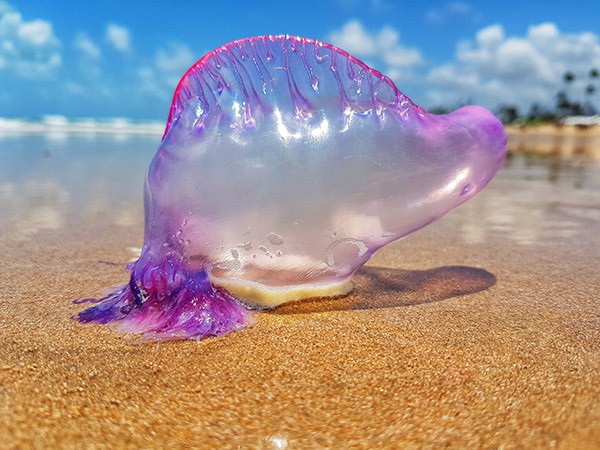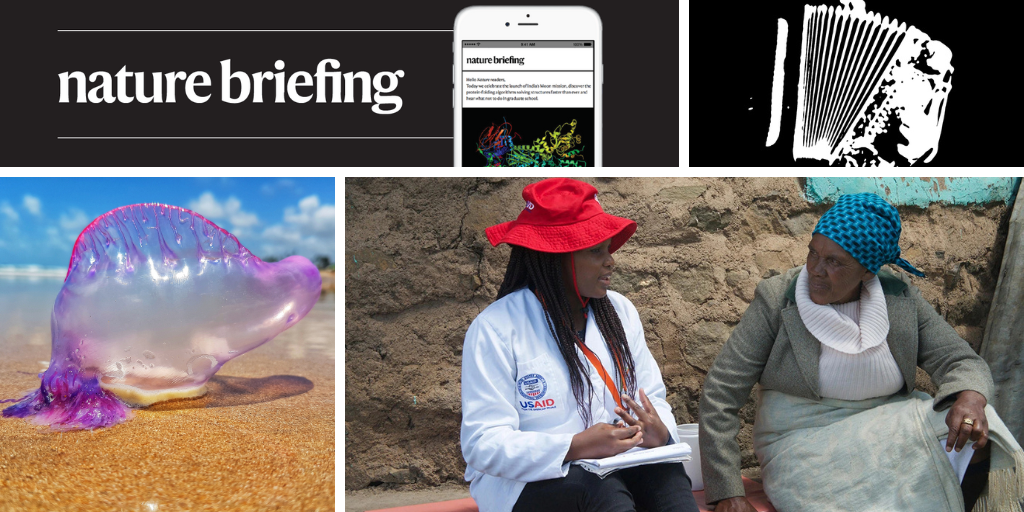You have full access to this article via your institution.
Hello Nature readers, would you like to get this Briefing in your inbox free every day? Sign up here.

Physalia can be stunningly beautiful — but don’t pet them, they have a powerful sting. (Katia Kalinowski/iStock via Getty)
With its gas-filled float and muscular crest, Physalia — called the Portuguese man o’ war or bluebottle — sails the open seas, leading some to assume that they’re part of one big, well-mixed population. Not so, finds a study that sequenced the whole genomes of 151 animals gathered from around the world. There are at least four separate species, including a newly named one, Physalia minuta. “We were shocked, because we assumed they were all the same,” said marine ecologist and co-author Kylie Pitt. “But the genetic data clearly show they’re not only different, they’re not even interbreeding.”
Reference: Current Biology paper
In February, the US government cut all funding for the Demographic and Health Surveys (DHS) programme, which collects and publishes data on health, nutrition and gender equality in more than 90 countries. The cuts leave the future of the DHS’s highly cited database hanging in the balance. Now, the UN Statistical Commission, the world’s body that sets standards for statistics, has established a taskforce to assess how access to the database can continue. Funding from organizations such as the World Bank and the Gates Foundation could come to the rescue. The taskforce must also grapple with who owns the data, which will dictate how external funders can get involved.
Animals that live in the mountains, such as llamas and some goats, have a worse sense of smell than those that live nearer to sea level. Researchers found that high-altitude animals don’t have many genes that encode nasal receptors, and the higher they live, the fewer there are. These animals also have a smaller olfactory bulb — the brain region responsible for picking up scents — than their low-elevation counterparts. The outlier is humans — the team found that people who live in Tibet have a similar number of smell-related genes as do people who live in a nearby, much lower, region in China.
Reference: Current Biology paper
Features & opinion
Scientists are using the tools of neuroscience to reveal which regions of the brain are active during moments of insight, and how they interact when ‘eureka!’ strikes. They’ve refined the puzzles they use to trigger insight and the measurements they take, in an attempt to turn a self-reported, subjective experience into something that can be documented and rigorously studied. This foundational work has led to new questions, including why some people are more insightful than others, what mental states could encourage insight and how insight might boost memory.

Researchers sometimes use two-tone images known as Mooney images to generate ‘aha!’ moments of sudden insight in study participants. The insight arrives when what’s shown in the image becomes clear. Have a go with a series of Mooney images created by the Nature art team: click through to the article to take the quiz. (Getty. Image processed with code created by: Imamoglu, F., Kahnt, T., Koch, C. & Haynes, J. D. Neuroimage 63, 1909–1917; 2012)
With legs, a central brain and a peripheral nervous system, tardigrades sit in a sweet spot for scientists: simple enough to study easily and intricate enough for it to be worth doing so. That could make them good ‘model organisms’ — a species used to extensively probe into one aspect of biology — for studying how neural circuits work, say some neuroscientists. The microscopic animals aren’t ideal candidates, not least because researchers aren’t sure what types of neuron the creatures have, or how many. Nonetheless, tardigrade enthusiasts are ready to fight their corner. “I have faith in the tardigrade community,” says organismal biologist Jasmine Nirody. “We’re determined.”
In response to an article published in March about using artificial intelligence (AI) to streamline peer review, researchers Carl Bergstrom and Joe Bak-Coleman question whether there are areas of scientific work where AI should not go. “Reading the literature, drafting manuscripts and engaging in peer review, for example … rely on something even more precious than our time: namely, our capacity for scientific decision-making,” write the authors, who study how digital information technologies affect society. “It is worth considering what we lose when we cede that — and our agency — to machines.”
If you enjoy this newsletter, I’d be very grateful if you were to recommend it to a friend or colleague. Please click here to forward it by e-mail. Thank you!
Thanks for reading,
Flora Graham, senior editor, Nature Briefing
With contributions by Jacob Smith
• Nature Briefing: Careers — insights, advice and award-winning journalism to help you optimize your working life
• Nature Briefing: Microbiology — the most abundant living entities on our planet — microorganisms — and the role they play in health, the environment and food systems
• Nature Briefing: Anthropocene — climate change, biodiversity, sustainability and geoengineering
• Nature Briefing: AI & Robotics — 100% written by humans, of course
• Nature Briefing: Cancer — a weekly newsletter written with cancer researchers in mind
• Nature Briefing: Translational Research — covers biotechnology, drug discovery and pharma


